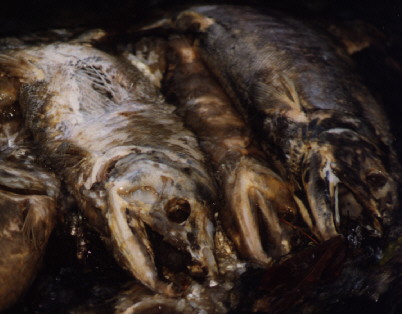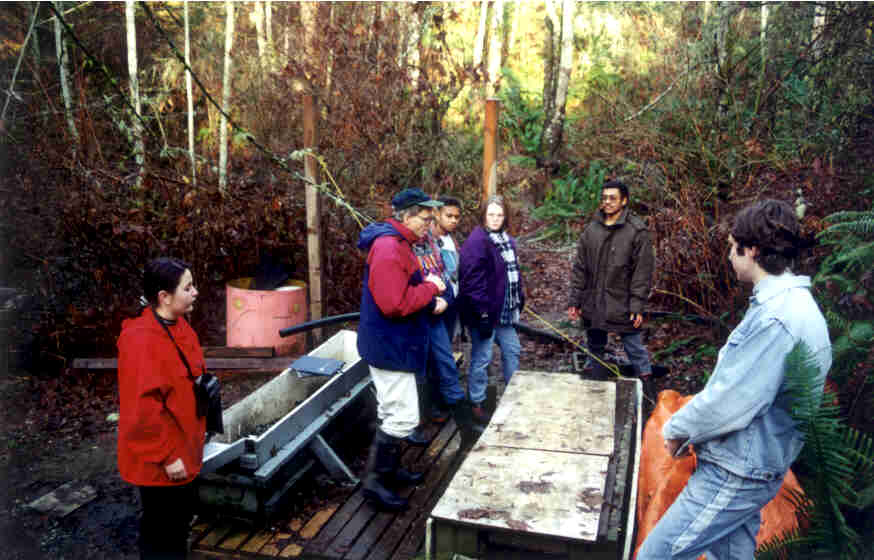
Dead Chum Salmon after egg and sperm removal for the Salmon Enhancement Program at Pearson College- in the 1980s
DESCRIPTION: Ocean fresh chum salmon are metallic greenish-blue on the dorsal surface (top) with fine black speckles. They are difficult to distinguish from Sockeye and Coho salmon without examining their gills or caudal fin scale patterns. Chums have fewer but larger gill rakers than other salmon. After nearing fresh water, however, the chum salmon changes colour – particularly noticeable are vertical bars of green and purple, which give them the common name, calico salmon. The males develop the typical hooked snout of Pacific salmon and very large teeth which partially account for their other name of dog salmon. The females have a dark horizontal band along the lateral line; their green and purple vertical bars are not so obvious. A mature adult chum is usually about 65 cm in length and 4.5 kg (10 pounds) in weight. The females are generally smaller than the males.
DISTRIBUTION: Chum salmon are probably the second most abundant of the Pacific salmon (behind pinks) and have the widest distribution of this group. They are found from Japan and Korea northward to the Laptev Sea (northern Siberia) and Beaufort Sea (northern Alaska) and southward to San Diego, southern California. DNA analyses indicate that there are three main population groupings: 1) Japanese, 2) Russian – Yukon River and 3) southeastern Alaska – British Columbia. These may reflect the areas of refuge for this species during the last glaciation.
Domain Eukarya
Kingdom Animalia
Phylum Chordata
Subphylum Vertebrata
Class Actinopterygii
Order Salmoniformes
Family Salmonidae
Genus Oncorhynchus
Species keta (Walbaum, 1792)
Common Name: chum salmon
HABITAT: Research indicates that streams, coastal wetlands and estuaries are important habitats for chum salmon. Stream quality is critical to the initial survival of the species. Eggs are laid in medium size gravel and need good water flow (to supply oxygen) to survive. Most chum mortality occurs in freshwater as a result of poor environmental conditions, like siltation, gravel disruptions and changes in water temperature. Coastal wetlands and estuaries are vital habitat for chum salmon which spend several months in residence before migrating out to sea.
FEEDING: Chum salmon feeds on squid, plankton, crustaceans, crab larvae and fish while at sea. They will stop feeding once the spawning run starts and they enter fresh water.
PREDATORS: The most important predators are: bears, birds and fishes. Gulls and other birds aggregate at river-mouths during the season of chum salmon for feeding with chum salmon.
REPRODUCTION: Chum salmon’s life cycle is a typical anadromous life cycle. Their average life span is four years but some may reach six years. Reproduction takes place in small river channels, chum salmon are typically shallow spawners. Female fish rapidly pump their tails to wash out a depression in the stream gravels. As she deposits her eggs, they are fertilized by the male. . The female salmon then uses the same tail movements to completely cover the eggs with the gravel.
On average, a female chum salmon can lay up to 4000 eggs, but only 70% or so are fertilized. After the reproduction the male and female chum salmon die in the stream, it is the cycle of their life.
ONE INTERESTING FACT:
* During ocean migration, salmon travel distances as great as 35 miles per day, and, once in their home river, may swim over 10 miles upstream each day. Chum usually spawn in their 3rd, 4th, or 5th year and is the last of the Pacific salmon to return to their natal streams. So their life cycle is they have to be born and die in the same place (stream).
* ‘Chum’ comes from a word meaning ‘variegated coloration’ in the native language and chum salmon have a different coloration (from other salmon species) that is variegated.
REFERENCE:
Wikipedia, the free encyclopedia.
http://www.fishtrek.com/salmon/chum-salmon.htm
www.google.com
chum salmon Fishing Holidays.htm
ESPN Outdoors — Tips & Techniques.htm
Fishing & Processing.htm
M010003.htm
The Chum Salmon Great Canadian Rivers.htm
WDFW — Chum Salmon Chum Salmon Life History.htm
Wild Pacific Salmon Overview.htm
Yukon River Panel -.htm
Andy Lamb and Phil Edgell: “Coastal fishes of the Pacific Northwest”
J.L Hart: “Pacific fishes of Canada”
| Other Members of the Class Actinopterygii at Race Rocks |
and Image File |
 The Race Rocks taxonomy is a collaborative venture originally started with the Biology and Environmental Systems students of Lester Pearson College UWC. It now also has contributions added by Faculty, Staff, Volunteers and Observers on the remote control webcams. The Race Rocks taxonomy is a collaborative venture originally started with the Biology and Environmental Systems students of Lester Pearson College UWC. It now also has contributions added by Faculty, Staff, Volunteers and Observers on the remote control webcams.
Name: Cinthia Ibeth Isla Marin, Peru, Year 32 (PC) |

